parking sensors Abarth 500 2017 Owner handbook (in English)
[x] Cancel search | Manufacturer: ABARTH, Model Year: 2017, Model line: 500, Model: Abarth 500 2017Pages: 192, PDF Size: 6.46 MB
Page 55 of 192
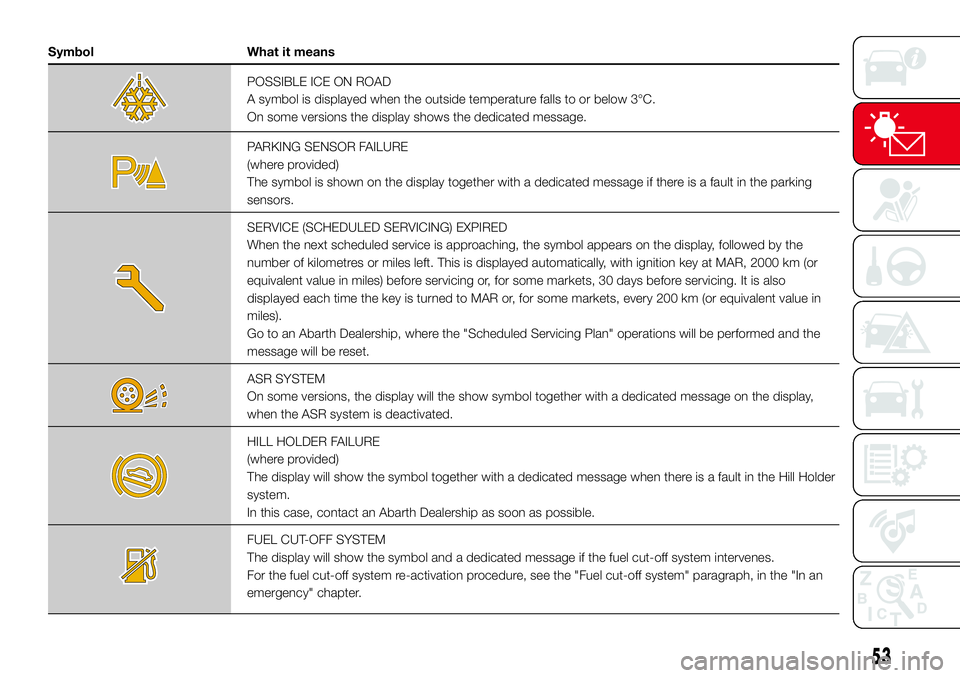
Symbol What it means
POSSIBLE ICE ON ROAD
A symbol is displayed when the outside temperature falls to or below 3°C.
On some versions the display shows the dedicated message.
PARKING SENSOR FAILURE
(where provided)
The symbol is shown on the display together with a dedicated message if there is a fault in the parking
sensors.
SERVICE (SCHEDULED SERVICING) EXPIRED
When the next scheduled service is approaching, the symbol appears on the display, followed by the
number of kilometres or miles left. This is displayed automatically, with ignition key at MAR, 2000 km (or
equivalent value in miles) before servicing or, for some markets, 30 days before servicing. It is also
displayed each time the key is turned to MAR or, for some markets, every 200 km (or equivalent value in
miles).
Go to an Abarth Dealership, where the "Scheduled Servicing Plan" operations will be performed and the
message will be reset.
ASR SYSTEM
On some versions, the display will the show symbol together with a dedicated message on the display,
when the ASR system is deactivated.
HILL HOLDER FAILURE
(where provided)
The display will show the symbol together with a dedicated message when there is a fault in the Hill Holder
system.
In this case, contact an Abarth Dealership as soon as possible.
FUEL CUT-OFF SYSTEM
The display will show the symbol and a dedicated message if the fuel cut-off system intervenes.
For the fuel cut-off system re-activation procedure, see the "Fuel cut-off system" paragraph, in the "In an
emergency" chapter.
53
Page 63 of 192
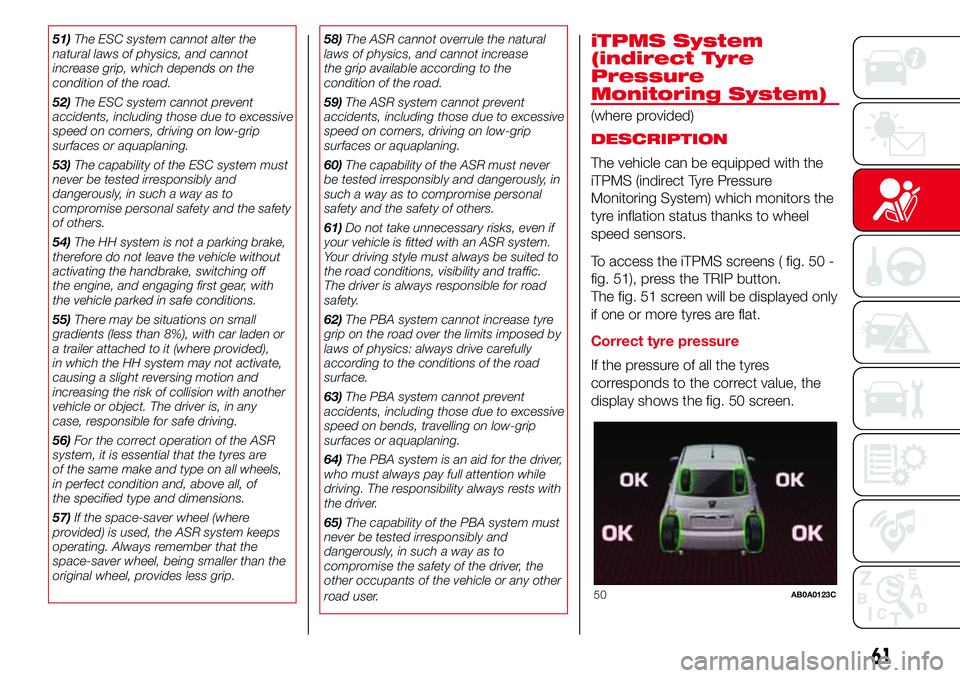
51)The ESC system cannot alter the
natural laws of physics, and cannot
increase grip, which depends on the
condition of the road.
52)The ESC system cannot prevent
accidents, including those due to excessive
speed on corners, driving on low-grip
surfaces or aquaplaning.
53)The capability of the ESC system must
never be tested irresponsibly and
dangerously, in such a way as to
compromise personal safety and the safety
of others.
54)The HH system is not a parking brake,
therefore do not leave the vehicle without
activating the handbrake, switching off
the engine, and engaging first gear, with
the vehicle parked in safe conditions.
55)There may be situations on small
gradients (less than 8%), with car laden or
a trailer attached to it (where provided),
in which the HH system may not activate,
causing a slight reversing motion and
increasing the risk of collision with another
vehicle or object. The driver is, in any
case, responsible for safe driving.
56)For the correct operation of the ASR
system, it is essential that the tyres are
of the same make and type on all wheels,
in perfect condition and, above all, of
the specified type and dimensions.
57)If the space-saver wheel (where
provided) is used, the ASR system keeps
operating. Always remember that the
space-saver wheel, being smaller than the
original wheel, provides less grip.58)The ASR cannot overrule the natural
laws of physics, and cannot increase
the grip available according to the
condition of the road.
59)The ASR system cannot prevent
accidents, including those due to excessive
speed on corners, driving on low-grip
surfaces or aquaplaning.
60)The capability of the ASR must never
be tested irresponsibly and dangerously, in
such a way as to compromise personal
safety and the safety of others.
61)Do not take unnecessary risks, even if
your vehicle is fitted with an ASR system.
Your driving style must always be suited to
the road conditions, visibility and traffic.
The driver is always responsible for road
safety.
62)The PBA system cannot increase tyre
grip on the road over the limits imposed by
laws of physics: always drive carefully
according to the conditions of the road
surface.
63)The PBA system cannot prevent
accidents, including those due to excessive
speed on bends, travelling on low-grip
surfaces or aquaplaning.
64)The PBA system is an aid for the driver,
who must always pay full attention while
driving. The responsibility always rests with
the driver.
65)The capability of the PBA system must
never be tested irresponsibly and
dangerously, in such a way as to
compromise the safety of the driver, the
other occupants of the vehicle or any other
road user.iTPMS System
(indirect Tyre
Pressure
Monitoring System)
(where provided)
DESCRIPTION
The vehicle can be equipped with the
iTPMS (indirect Tyre Pressure
Monitoring System) which monitors the
tyre inflation status thanks to wheel
speed sensors.
To access the iTPMS screens ( fig. 50 -
fig. 51), press the TRIP button.
The fig. 51 screen will be displayed only
if one or more tyres are flat.
Correct tyre pressure
If the pressure of all the tyres
corresponds to the correct value, the
display shows the fig. 50 screen.
50AB0A0123C
61
Page 83 of 192
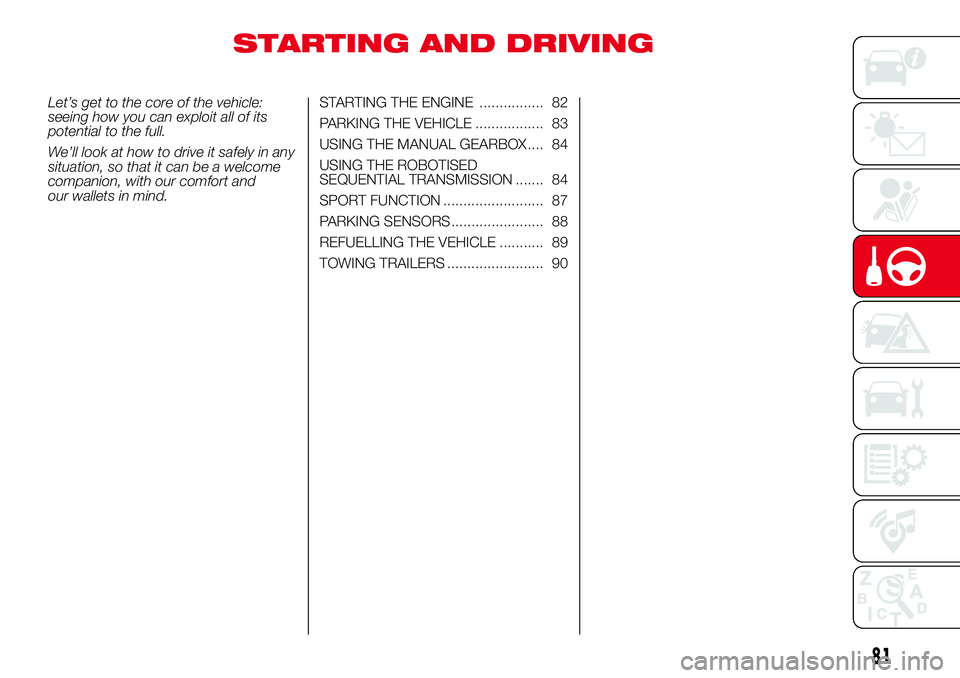
STARTING AND DRIVING
Let’s get to the core of the vehicle:
seeing how you can exploit all of its
potential to the full.
We’ll look at how to drive it safely in any
situation, so that it can be a welcome
companion, with our comfort and
our wallets in mind.STARTING THE ENGINE ................ 82
PARKING THE VEHICLE ................. 83
USING THE MANUAL GEARBOX .... 84
USING THE ROBOTISED
SEQUENTIAL TRANSMISSION ....... 84
SPORT FUNCTION ......................... 87
PARKING SENSORS....................... 88
REFUELLING THE VEHICLE ........... 89
TOWING TRAILERS ........................ 90
81
Page 90 of 192
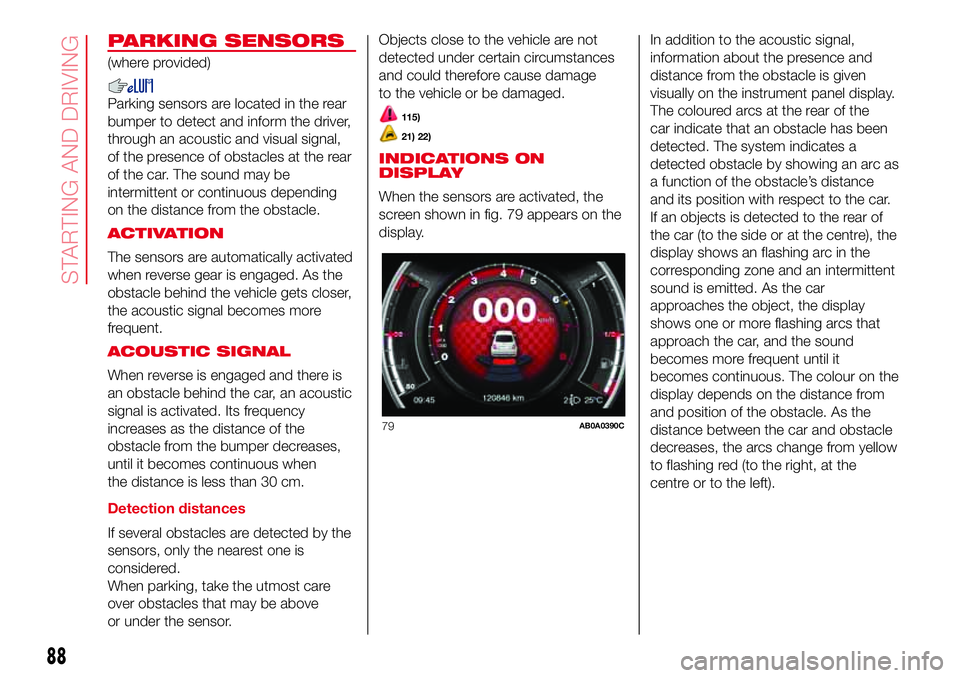
PARKING SENSORS
(where provided)
Parking sensors are located in the rear
bumper to detect and inform the driver,
through an acoustic and visual signal,
of the presence of obstacles at the rear
of the car. The sound may be
intermittent or continuous depending
on the distance from the obstacle.
ACTIVATION
The sensors are automatically activated
when reverse gear is engaged. As the
obstacle behind the vehicle gets closer,
the acoustic signal becomes more
frequent.
ACOUSTIC SIGNAL
When reverse is engaged and there is
an obstacle behind the car, an acoustic
signal is activated. Its frequency
increases as the distance of the
obstacle from the bumper decreases,
until it becomes continuous when
the distance is less than 30 cm.
Detection distances
If several obstacles are detected by the
sensors, only the nearest one is
considered.
When parking, take the utmost care
over obstacles that may be above
or under the sensor.Objects close to the vehicle are not
detected under certain circumstances
and could therefore cause damage
to the vehicle or be damaged.115)
21) 22)
INDICATIONS ON
DISPLAY
When the sensors are activated, the
screen shown in fig. 79 appears on the
display.In addition to the acoustic signal,
information about the presence and
distance from the obstacle is given
visually on the instrument panel display.
The coloured arcs at the rear of the
car indicate that an obstacle has been
detected. The system indicates a
detected obstacle by showing an arc as
a function of the obstacle’s distance
and its position with respect to the car.
If an objects is detected to the rear of
the car (to the side or at the centre), the
display shows an flashing arc in the
corresponding zone and an intermittent
sound is emitted. As the car
approaches the object, the display
shows one or more flashing arcs that
approach the car, and the sound
becomes more frequent until it
becomes continuous. The colour on the
display depends on the distance from
and position of the obstacle. As the
distance between the car and obstacle
decreases, the arcs change from yellow
to flashing red (to the right, at the
centre or to the left).
79AB0A0390C
88
STARTING AND DRIVING
Page 91 of 192
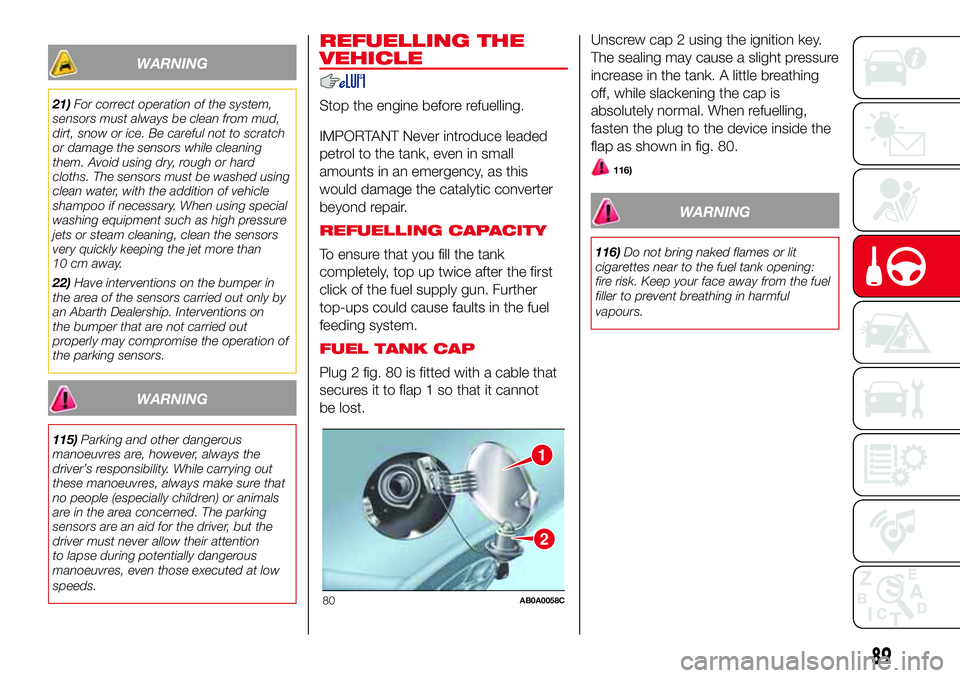
WARNING
21)For correct operation of the system,
sensors must always be clean from mud,
dirt, snow or ice. Be careful not to scratch
or damage the sensors while cleaning
them. Avoid using dry, rough or hard
cloths. The sensors must be washed using
clean water, with the addition of vehicle
shampoo if necessary. When using special
washing equipment such as high pressure
jets or steam cleaning, clean the sensors
very quickly keeping the jet more than
10 cm away.
22)Have interventions on the bumper in
the area of the sensors carried out only by
an Abarth Dealership. Interventions on
the bumper that are not carried out
properly may compromise the operation of
the parking sensors.
WARNING
115)Parking and other dangerous
manoeuvres are, however, always the
driver’s responsibility. While carrying out
these manoeuvres, always make sure that
no people (especially children) or animals
are in the area concerned. The parking
sensors are an aid for the driver, but the
driver must never allow their attention
to lapse during potentially dangerous
manoeuvres, even those executed at low
speeds.
REFUELLING THE
VEHICLE
Stop the engine before refuelling.
IMPORTANT Never introduce leaded
petrol to the tank, even in small
amounts in an emergency, as this
would damage the catalytic converter
beyond repair.
REFUELLING CAPACITY
To ensure that you fill the tank
completely, top up twice after the first
click of the fuel supply gun. Further
top-ups could cause faults in the fuel
feeding system.
FUEL TANK CAP
Plug 2 fig. 80 is fitted with a cable that
secures it to flap 1 so that it cannot
be lost.Unscrew cap 2 using the ignition key.
The sealing may cause a slight pressure
increase in the tank. A little breathing
off, while slackening the cap is
absolutely normal. When refuelling,
fasten the plug to the device inside the
flap as shown in fig. 80.
116)
WARNING
116)Do not bring naked flames or lit
cigarettes near to the fuel tank opening:
fire risk. Keep your face away from the fuel
filler to prevent breathing in harmful
vapours.
1
2
80AB0A0058C
89
Page 188 of 192
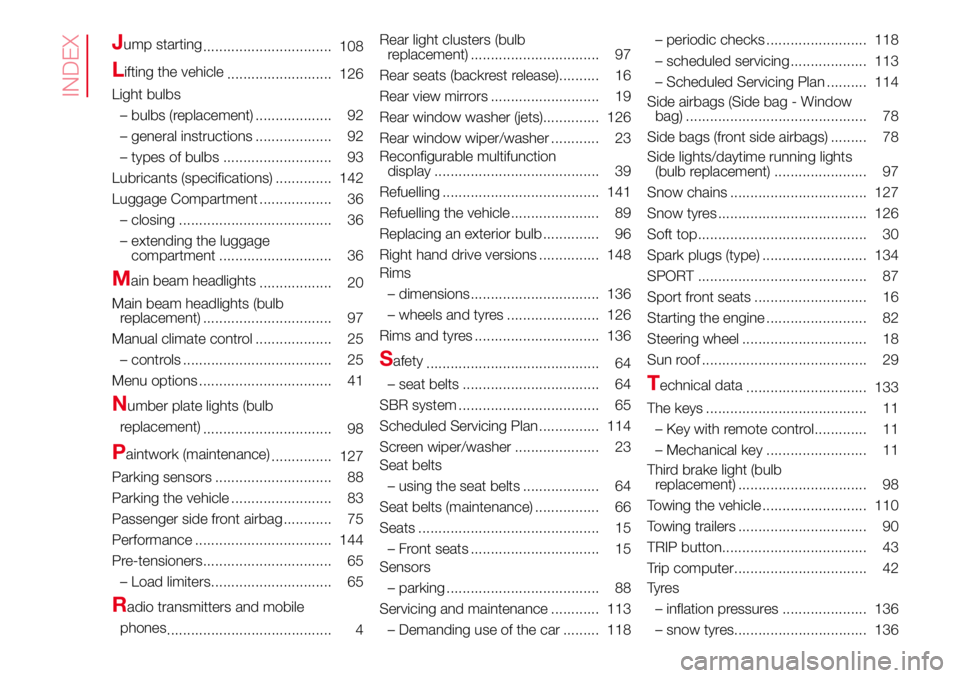
Jump starting
................................ 108
Lifting the vehicle
.......................... 126
Light bulbs
– bulbs (replacement) ................... 92
– general instructions ................... 92
– types of bulbs ........................... 93
Lubricants (specifications) .............. 142
Luggage Compartment .................. 36
– closing ...................................... 36
– extending the luggage
compartment ............................ 36
Main beam headlights
.................. 20
Main beam headlights (bulb
replacement) ................................ 97
Manual climate control ................... 25
– controls ..................................... 25
Menu options ................................. 41
Number plate lights (bulb
replacement)
................................ 98
Paintwork (maintenance)
............... 127
Parking sensors ............................. 88
Parking the vehicle ......................... 83
Passenger side front airbag ............ 75
Performance .................................. 144
Pre-tensioners................................ 65
– Load limiters.............................. 65
Radio transmitters and mobile
phones
......................................... 4Rear light clusters (bulb
replacement) ................................ 97
Rear seats (backrest release).......... 16
Rear view mirrors ........................... 19
Rear window washer (jets).............. 126
Rear window wiper/washer ............ 23
Reconfigurable multifunction
display ......................................... 39
Refuelling ....................................... 141
Refuelling the vehicle ...................... 89
Replacing an exterior bulb .............. 96
Right hand drive versions ............... 148
Rims
– dimensions................................ 136
– wheels and tyres ....................... 126
Rims and tyres ............................... 136
Safety
........................................... 64
– seat belts .................................. 64
SBR system ................................... 65
Scheduled Servicing Plan ............... 114
Screen wiper/washer ..................... 23
Seat belts
– using the seat belts ................... 64
Seat belts (maintenance) ................ 66
Seats ............................................. 15
– Front seats ................................ 15
Sensors
– parking ...................................... 88
Servicing and maintenance ............ 113
– Demanding use of the car ......... 118– periodic checks ......................... 118
– scheduled servicing ................... 113
– Scheduled Servicing Plan .......... 114
Side airbags (Side bag - Window
bag) ............................................. 78
Side bags (front side airbags) ......... 78
Side lights/daytime running lights
(bulb replacement) ....................... 97
Snow chains .................................. 127
Snow tyres ..................................... 126
Soft top.......................................... 30
Spark plugs (type) .......................... 134
SPORT .......................................... 87
Sport front seats ............................ 16
Starting the engine ......................... 82
Steering wheel ............................... 18
Sun roof ......................................... 29
Technical data
.............................. 133
The keys ........................................ 11
– Key with remote control............. 11
– Mechanical key ......................... 11
Third brake light (bulb
replacement) ................................ 98
Towing the vehicle .......................... 110
Towing trailers ................................ 90
TRIP button.................................... 43
Trip computer................................. 42
Ty r e s
– inflation pressures ..................... 136
– snow tyres................................. 136
INDEX